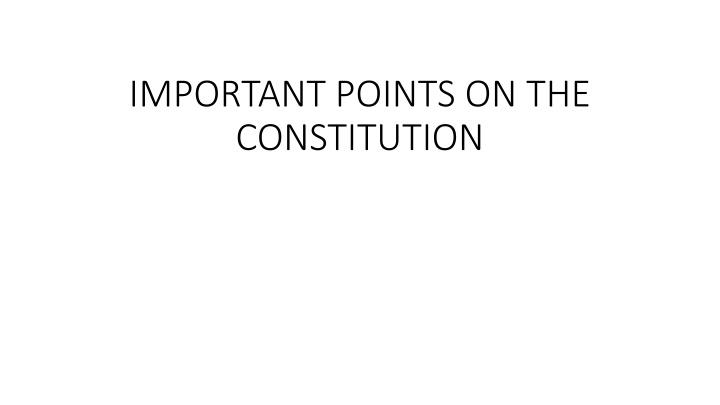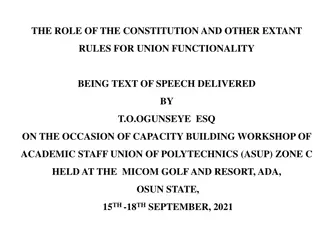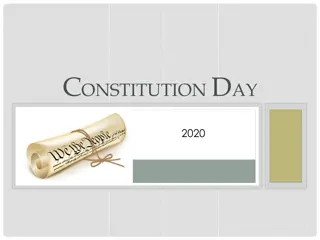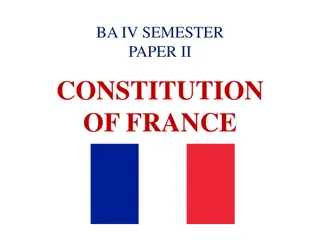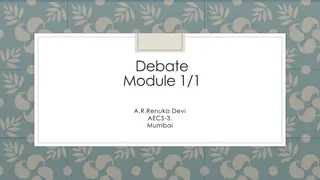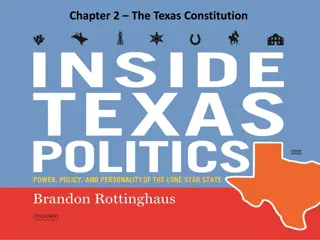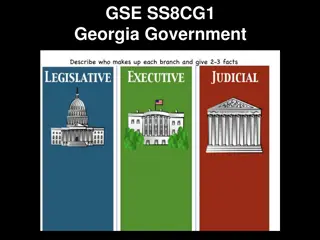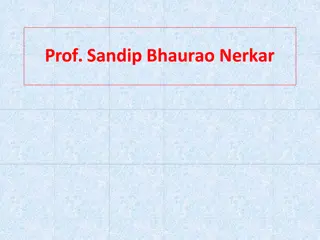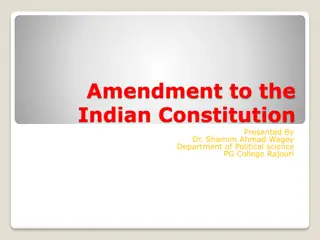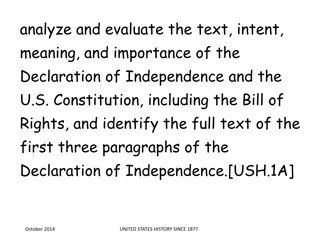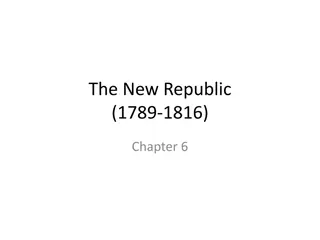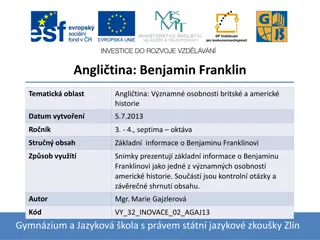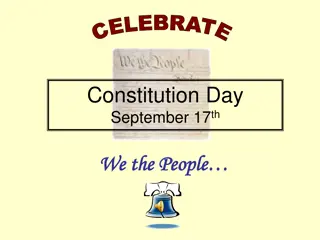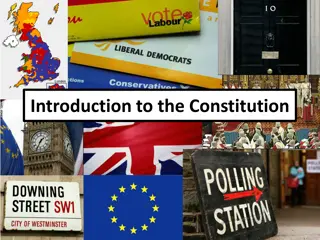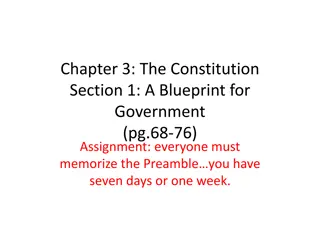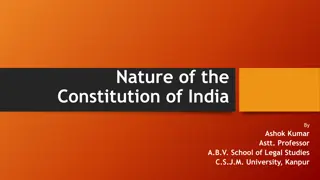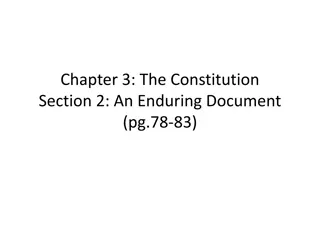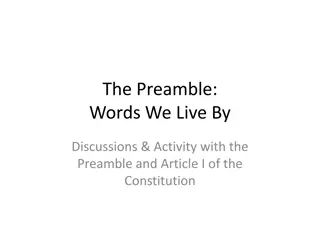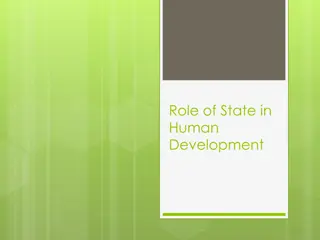Founding Principles and Debates in the Creation of the Constitution
The Constitution's formation was influenced by key principles such as Natural Rights and Popular Sovereignty, advocated by figures like John Locke and James Madison. The debates at the Constitutional Convention centered on issues like representation of states, separation of powers, and checks and balances. These discussions led to the adoption of foundational principles that shape the American government to this day.
Download Presentation

Please find below an Image/Link to download the presentation.
The content on the website is provided AS IS for your information and personal use only. It may not be sold, licensed, or shared on other websites without obtaining consent from the author.If you encounter any issues during the download, it is possible that the publisher has removed the file from their server.
You are allowed to download the files provided on this website for personal or commercial use, subject to the condition that they are used lawfully. All files are the property of their respective owners.
The content on the website is provided AS IS for your information and personal use only. It may not be sold, licensed, or shared on other websites without obtaining consent from the author.
E N D
Presentation Transcript
IMPORTANT POINTS ON THE CONSTITUTION
The English Heritage: the power of ideas John Locke s writings (Second Treatise) often called textbook of the American Revolution. Philosophy based on Natural Rights, the belief that people exist in the state of nature before governments existed. Also: 1) Natural law brings natural rights 2) Natural law superior to human law 3) Government must be built on the consent of the governed 4) Government should be limited 5) Sole Purpose of Government is to protect natural rights 6) Deep felt injustices could justify revolt
James Madison James Madison- - The Father of the Constitution Most influential member of the convention Believed the distribution of wealth was the source of political conflict Claimed factions arose from unequal distribution of property 1) One majority faction with little or no wealth 2)Other minority faction had the wealth Delegates believed that any faction unchecked could be tyrannical. Property must be protected from factions Government must be balanced so no faction could completely take over
Madisonian Principles of Govt in the Constitution Popular Sovereignty power to govern belongs to the people, gov t based on the consent of governed Separation of Powers division of gov t between branches: executive, legislative and judicial Checks and Balances a system where branches have some authority over others Limited Government gov t is not all-powerful, and it does only what citizens allow Federalism division of power between central government and individual states
10 MINUTE ACTIVITY .. DECIDE ON AN EXECUTIVE, JUDICIAL, AND LEGISLATIVE AT YOUR TABLE ..MAK E A LAW OR NOMINATE A SEAT AND FIND ALL WAYS TO CHECK EACH OTHER.
The Agenda in Philadelphia Constitution is silent on equality but many important issues on the agenda revolved around it: REPRESENTATION OF THE STATES: A) New Jersey Plan- equal representation in congress B) Virginia Plan- base representation on population C) Connecticut Compromise- bicameral legislature
The Agenda in Philadelphia- cont POLITICAL EQUALITY: A)Some delegates wanted suffrage for all free, adult males B) Ultimately decided to leave issues to the states .ELECTIONS ARE REGULATED BY STATES!
What did the Constitution do?? Spelled out the economic powers of congress: A) Chief economic policy maker B) Power to tax, borrow and appropriate funds C) Powers to protect property rights, punish counterfeiters, issue patents, etc. FIND IT! ON YOUR MARK, GO!
POWERS PROHIBITED TO THE STATES ..WHERE? Prohibited states from certain practices like: A) State monetary system B) Placing duties on other states goods C) Interfering with lawful debts WHAT IF IT S NOT PROHIBITED TO THE STATES, BUT ISN T MENTIONED IN THE CONSTITUTION?.........WHAT ADDRESSES THIS?
What ELSE did the Constitution do?? INDIVIDUAL RIGHTS: A) Felt preserving individual rights would be easy B) After all, they were creating a limited government C) powers were dispersed so each branch could check the others D) Most felt states were already protecting rights WOULD THE CONSTITUTION WORK AS WELL WITHOUT A NATIONAL BILL OF RIGHTS?
What ELSE did the Constitution do?? Mentioned little about personal freedoms but it did say: A) the writ of habeas corpus maynot be suspended unless during war B) Congress could not pass bills of attainder (punishment without trial) or ex post facto laws C) Religious qualifications could not be used to hold public office D) Treason is narrowly defined E) The right to trial by jury in criminal cases is guaranteed .WHERE? THE ABSENCE OF A SPECIFIC BILL OF RIGHTS LED TO ISSUES OVER RATIFICATION
Check this out.. Executive: A) checks legislative with veto power B) checks judicial by nominating/appointing judges Legislative: A) checks executive with purse power budget B) checks judicial by confirmation of appointments Judicial: A) Checks executive and legislative through judicial review ..not written in article III .precedent established in Marbury v Madison
Ratifying the Constitution Federalists versus Anti-Federalists FEDERALISTS: A) James Madison, Alexander Hamilton, John Jay- writing under the name Publius, wrote 85 articles called the Federalist papers B) Defended the Constitution and called for its ratification ANTI-FEDERALISTS: A) Questioned the motives of the framers B) Believed it was a class-based document to serve the elite C) Said the document would erode both personal freedom and the powers of the states
Federalist #10 Madison addresses biggest fear of gov t Faction a group in a legislature or political party acting together in pursuit of some special interest (think fraction , 1/3, etc) Founding fathers were concerned that our government would be ripped apart Madison defends our national Constitution
Federalist #10 Separation of Powers check the growth of tyranny Each branch of government keeps the other two from gaining too much power A republic guards against irresponsible direct democracy or common passions Factions will always exist, but must be managed to not severe from the system.
Anti-Fed Response Central gov t would threaten liberty Aristocratic tyranny could happen Demanded a guarantee of individual rights and liberty States power was too limited
Compromise and Ratification Federalists agreed to add amendments to the document to assure personal freedoms A) James Madison introduced 12 potential amendments during the 1st congress in 1789 ..27 was actually #2 at one time .READ B) 10 of these amendments, the Bill of Rights, were ratified by the states and took effect in 1791 RATIFICATION: 1) Federalists specified ratification to be conducted through special conventions in each state 2) 9 of 13 states had to ratify for it to take effect 3) Delaware was first and New Hampshire was ninth some six months later 4) George Washington was the unanimous choice to be the 1st president
Constitutional Change Formal Amendment: 1) Changes the actual wording of the document 2) Two stages to the process A) Proposal- by either a 2/3 vote in each of congress or by a national convention called by congress at the request of 2/3 of state legislatures B) Ratification- approval of either legislatures of of the states or by special conventions in of the states Note: All amendments have been proposed by congress
Constitutional Change Informal Amendment: 1) Changes the spirit of the document A) Judicial interpretation- how it is interpreted .Brown v Board B) Political practice- for example the electoral college is different today than was intended C) Technology- mass media, bureaucracy has grown, communications and advanced weapons power of the Pres D) Power of the president has grown as a result of new demands for public policy- (superpower and domestic policy) War Powers resolution
